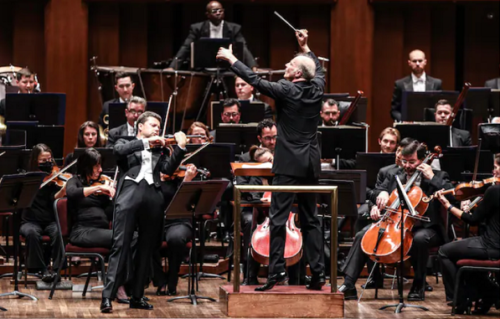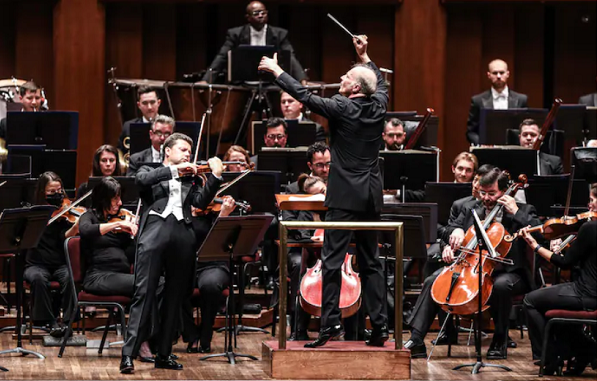 United States Respighi, Tchaikovsky, Casella: Julian Rachlin (violin), National Symphony Orchestra / Gianandrea Noseda (conductor). Kennedy Center, Washington, 27.10.2022. (RRR)
United States Respighi, Tchaikovsky, Casella: Julian Rachlin (violin), National Symphony Orchestra / Gianandrea Noseda (conductor). Kennedy Center, Washington, 27.10.2022. (RRR)

Respighi – Burlesca for Orchestra
Tchaikovsky – Violin Concerto
Alfredo Casella – Symphony No.3
Conductor Gianandrea Noseda opened this National Symphony Orchestra’s concert by playing a fairly obscure early piece by Italian composer Ottorino Respighi. Anyone who knows and loves his Pines of Rome, Fountains of Rome, and Roman Festivals will immediately sense the same atmospherics in the Burlesca for Orchestra, which the then 27-year-old Respighi wrote in 1906, some ten years before he started on the works above. Musicologist Guido Elberfeld finds the Burlesca already exuding Respighi’s typical ‘Mediterranean-iridescent lustrousness of the orchestral sound,’ as well as his ‘impressionistically colored tonality in melody and harmony.’ In other words, at an early stage he was already in possession of the soundworld out of which those later, highly popular works would emerge. Unfortunately, the latter triptych’s wild popularity practically buried the Burlesca and some of Respighi’s other works. Burlesca’s score was not published until some 20 years ago and its first recording was not issued until 2001. Noseda and the NSO ever so gently captured the diaphanous, impressionist opening, launching us into this magical world with its sparkling orchestration. After building to several impressive climaxes with sounding brass and thundering timpani, he gently put the Burlesca to rest in this very lovely performance that captured the sheer fantasy of the piece.
In all likelihood, most of the audience came to hear Tchaikovsky’s Violin Concerto. Though it was composed during a turbulent, unhappy period in Tchaikovsky’s life, his holiday on Lake Geneva in 1878 appears to have refreshed him to the point that this work came easily to him and was unburdened by any of the near-hysterical pathos that occasionally crept into his later works. What makes it so easy to listen to is that Tchaikovsky wasn’t aiming at profundity here. Speaking of his elation at the time of the Concerto’s composition, he wrote: ‘In such a state of mind creative work sheds all its irksomeness of toil; it is purest bliss.’ Thus, in the space of only several weeks, was born one of the most popular violin concertos ever composed.
However, the concerto’s preparation for performance faced obstacles. The first two violinists to whom Tchaikovsky offered it pronounced it impossible to play owing to the many double stops, glissandi, trills, leaps, and dissonances. Finally, Austrian violinist Alexander Brodsky stepped in to play the premiere in Vienna in 1879. It was not universally greeted. Viennese music critic Eduard Hanslick savaged the piece: ‘Tchaikovsky’s Violin Concerto gives us for the first time the hideous notion that there can be music that stinks to the ear.’ Few found it odiferous and it quickly grew in popularity.
Julian Rachlin met the work’s many challenges in a very engaging performance. Noseda and Rachlin were perfectly in sync with each other across the work’s broad range of expression. At no point did Noseda allow the orchestra to overwhelm the soloist. They were partners rather than antagonists. There are many things to compliment, but I must particularly remark on the exquisite refinement and beauty of the Andante. Even in overly familiar music such as this, experiencing it played at such a level of excellence was a great pleasure.
I confess that I came to hear, not Tchaikovsky, but Alfredo Casella’s Third Symphony. When Noseda began his tenure at the NSO, I had high hopes that he would bring to Washington D.C. many of the musical treasures of his homeland, but apparently, Washington audiences are addicted to the basic repertory, which is programmed ad nauseam. Noseda did introduce audiences to Casella’s music in 2015 with the Elegia eroica, followed by the Second Symphony back in 2019, but that is a long time between drinks. A Gramophone magazine reviewer once castigated this symphony by saying it prefigures ‘the worst kind of movie music bathos, though even Cecil B. De Mille might have balked at having his more sentimental images so relentlessly underlined,’ Yes, it is that good, as Noseda’s performance of it proved.
In any case, it was worth the wait to hear the Third Symphony. By way of background information, Noseda is somewhat of a Casella specialist. He recorded the three symphonies and other orchestral works with the BBC Philharmonic for the Chandos label about a decade ago. Casella needed the advocacy, because his once-substantial reputation evaporated after World War II, when the avant-garde took over. Memories of Casella flickered more as a pianist, conductor (including of the Boston Pops), and teacher (the great film composer Nino Rota was one of his students), than as a composer. Scarlattiana was about the only composition that survived his eclipse.
Symphony No.3 comes from a neo-classical soundworld, with shades of Shostakovich and Stravinsky. Gone are all the excesses that the Gramophone reviewer deplored. However, the melodies remain. It could otherwise almost pass as a product of mainstream American symphonism of the mid-twentieth century. In fact, it was commissioned by conductor Frederick Stock for the 50th anniversary of the Chicago Symphony Orchestra and was a huge hit at its premiere. The only mystery is why it has taken this long to revive.
It is a work of great organic unity with a main theme that is almost omnipresent, though in often varied and sometimes subtle ways. It is almost impossible to lose your way in this wonderful work, even amidst its complexities. Its second movement Andante possesses a sweet lyricism and beauty that are redolent of Samuel Barber. The NSO winds deserve special credit for the exquisite way in which they carried the lovely main theme. The Scherzo is the most Shostakovich-like movement of the work with its pile-driving rhythms, but it is a friendlier version of Shostakovich, without his minatory sense. The fourth movement Rondo is an exuberant, almost celebratory finale filled with delight. Needless to say, it concludes with the restatement of the opening theme.
Noseda drove the music with an exciting sense of grip, though without losing any detail or scanting the delicate moments. There was playing of great character in every department of the NSO, with the winds and brass shining especially.
In Casella’s fully mature period, of which the Third is a prime example, he achieved a balance of form and substance that led to some highly original works that expressed the ‘logical discursiveness’ that he so admired. Whatever Casella did across his myriad styles, he did it wholeheartedly. His music embraces you; it is hard not to embrace it back.
Viva Italia! More, please (how about one of Malipiero’s magical symphonies?).
Robert R. Reilly
